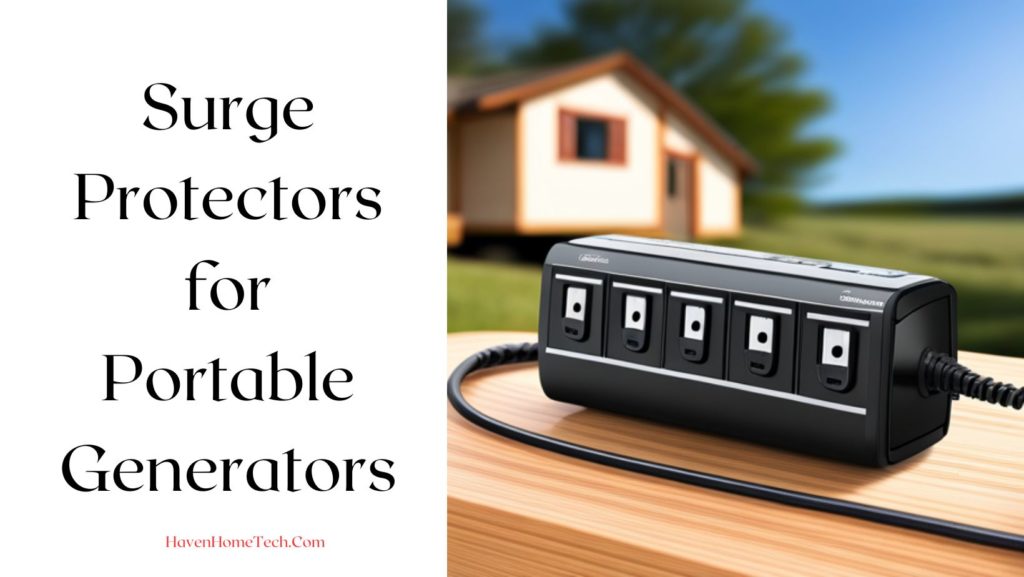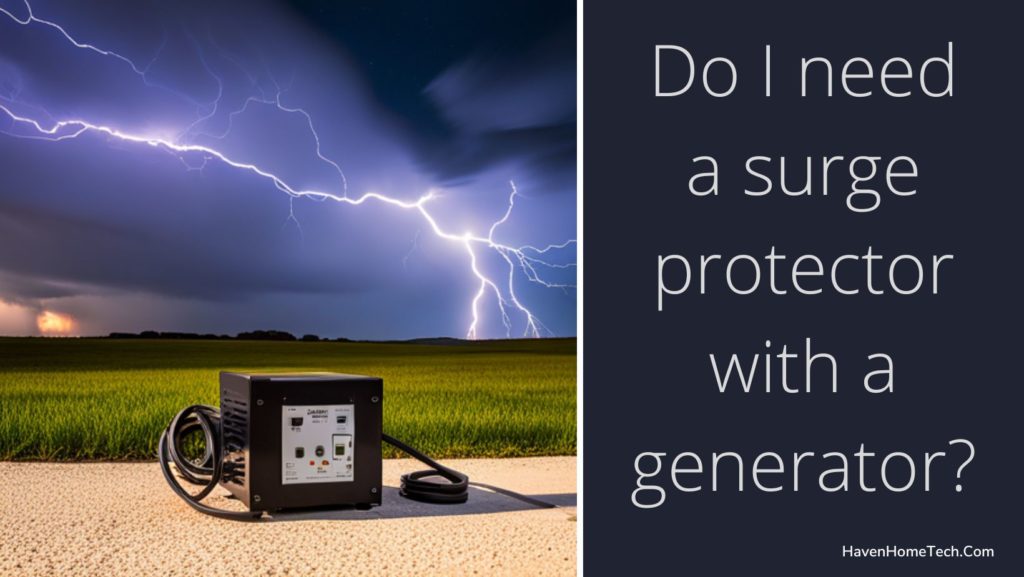Are you considering purchasing a generator for your home or business? If so, it’s important to understand the potential risks of power surges that can damage your generator and connected appliances.
Power surges can occur when the flow of electricity is interrupted and then resumed, causing a sudden increase in voltage that can damage electronics and appliances. That’s why it’s essential to invest in a surge protector for your generator.

Choosing the best surge protector for your generator can be a challenge, as there are many options on the market. Some surge protectors are designed specifically for generators, while others are more general-purpose.
It’s important to consider factors like the size of your generator, the type of appliances you’ll be using, and the level of protection you need to ensure that you choose the right surge protector for your needs.
Quick Navigation in this Resource
- 1 Why Does My Generator Surge?
- 2 Choosing the Best Surge Protectors for Generators
- 3 The Need for a Surge Protector with a Generator
- 4 Generator Transfer Switch Surge Protector
- 5 Frequently Asked Questions
- 5.1 What causes a generator to surge?
- 5.2 What is the best surge protector for a portable generator?
- 5.3 How do I install a Generac surge protector?
- 5.4 Do I need a surge protector for my generator transfer switch?
- 5.5 Can a surge protector be used with an inverter generator?
- 5.6 How can I protect my electronics from power surges caused by my generator?
- 5.7 Is it necessary to use a surge protector with a whole house generator?
- 5.8 Can you use a surge protector with a generator?
Key Takeaways
- Power surges can damage your generator and connected appliances, making a surge protector essential.
- Choosing the right surge protector for your generator requires considering factors like generator size, appliance type, and level of protection needed.
- A generator transfer switch surge protector can provide additional protection and convenience when using a generator.
Why Does My Generator Surge?
If you’ve ever experienced your generator surging, you know it can be frustrating and worrisome. But why does it happen? Here are some possible causes:
- Old age: Generators, like any other machine, have a lifespan. As they age, parts begin to wear out and become more susceptible to surging. If your generator is getting on in years, it may be time to consider replacing it.
- Fuel problems: If your generator is surging, it could be due to fuel issues. This could include a clogged fuel filter, stale fuel, or problems with the carburetor. Make sure you’re using fresh fuel and try cleaning or replacing the fuel filter to see if that helps.
- Governor spring: The governor spring on your generator helps regulate the engine speed. If it becomes disconnected or damaged, it can cause surging. Check the governor spring and make sure it’s in good condition and properly connected.
- Pilot jet: If your generator is surging at idle, it could be due to a clogged or restricted pilot jet on the carburetor. Cleaning or replacing the pilot jet may help resolve the issue.
- Load issues: If your generator is surging under load, it could be due to too much or too little load. Make sure you’re not overloading your generator and that you’re using the appropriate wattage for your appliances.
By identifying the cause of the surging, you can take steps to resolve the issue and keep your generator running smoothly.
Choosing the Best Surge Protectors for Generators
When it comes to finding the best surge protectors for generators, there are a few things to keep in mind. One of the most important factors to consider is the amperage of your generator. If you have a 30 amp generator, you will need a surge protector that can handle that level of power.
30 Amp Generator Surge Protector
A 30 amp generator surge protector is designed to protect your appliances and electronics from power surges and spikes. These surge protectors are specifically designed to work with generators that have a 30 amp output.
When choosing a 30 amp generator surge protector, there are a few things to consider. First, you want to make sure that the surge protector can handle the maximum amperage of your generator.
You also want to look for surge protectors that have a high joule rating, as this indicates that they can absorb more energy from power surges.
Some of the best 30 amp generator surge protectors on the market include the Progressive Industries SSP-30XL and the Surge Guard 44260.
Overall, choosing the right surge protector for your generator can help protect your appliances and electronics from costly damage. By considering factors like amperage and joule rating, you can find a surge protector that will provide reliable protection for years to come.
The Need for a Surge Protector with a Generator
When it comes to using a generator, it’s important to consider the safety of your electrical equipment. Power surges can occur when using a generator, which can damage your appliances and electronics.
That’s where a surge protector comes in.

Can you use a surge protector with a generator?
Absolutely! Surge protectors are designed to protect your electrical equipment from voltage spikes or surges. They usually have multiple outlets for appliances, and they will keep your equipment safe from spikes by blocking excess voltage.
Do you need a surge protector with a generator?
It’s highly recommended. Since the 2020 NEC code now requires a surge protector be included on all new generator installations, it’s clear that surge protection is an important consideration for generator use. By using a surge protector, you can protect your appliances and electronics from damage caused by power surges.
Should you use a surge protector with a generator?
Yes, you should. While it’s possible to use a generator without a surge protector, it’s not worth the risk of damaging your expensive appliances and electronics. A surge protector is an affordable and easy way to protect your equipment and ensure that your generator use is safe and reliable.
In summary, using a surge protector with a generator is highly recommended to protect your electrical equipment from power surges. It’s an affordable and easy way to ensure that your generator use is safe and reliable.
Generator Transfer Switch Surge Protector
If you have a whole-home or whole-house generator, you may want to consider adding a surge protector to control the flow of power into your home. A surge protector can help prevent damage to your appliances, electronics, and other equipment during a power outage.
A generator transfer switch surge protector is a device that helps protect your home’s electrical system from power surges caused by lightning strikes, power outages, or other electrical disturbances.
It is installed between the generator and the transfer switch, and it helps prevent damage to your home’s electrical system by absorbing the excess voltage that can occur during a power outage.
There are different types of generator transfer switch surge protectors available on the market, and they vary in terms of their features, price, and effectiveness. Some of the key features to look for when choosing a generator transfer switch surge protector include:
- Voltage protection rating: This is the maximum voltage that the surge protector can handle before it starts to fail. Look for a surge protector with a voltage protection rating that is higher than the voltage of your generator.
- Joule rating: This is a measure of the surge protector’s energy absorption capacity. The higher the joule rating, the better the surge protector will be at absorbing excess voltage.
- Response time: This is the time it takes for the surge protector to start absorbing excess voltage. Look for a surge protector with a fast response time, as this will help minimize the damage caused by power surges.
- Number of outlets: Make sure the surge protector has enough outlets to accommodate all of your appliances and electronics.
When installing a generator transfer switch surge protector, it is important to follow the manufacturer’s instructions carefully. Make sure the surge protector is installed correctly and that it is grounded properly to ensure maximum effectiveness.
When choosing a surge protector, look for one with a high voltage protection rating, joule rating, fast response time, and enough outlets to accommodate all of your equipment.
Frequently Asked Questions
What causes a generator to surge?
Generators can surge for a variety of reasons, including overloading, low fuel levels, or dirty air filters. In some cases, a surge can be caused by a faulty voltage regulator or a damaged alternator. It’s important to regularly maintain your generator to prevent surges and ensure it’s running smoothly.
What is the best surge protector for a portable generator?
There are many surge protectors available for portable generators, but it’s important to choose one that is specifically designed for use with generators. Look for a model with a high joule rating and multiple outlets to protect all of your devices.
How do I install a Generac surge protector?
Installation instructions for a Generac surge protector will vary depending on the model you choose. It’s important to follow the manufacturer’s instructions carefully to ensure proper installation and protection for your generator and electronics.
Do I need a surge protector for my generator transfer switch?
While some generator transfer switches may include surge protection, it’s always a good idea to use a separate surge protector for added protection. Look for a model that is compatible with your transfer switch and generator.
Can a surge protector be used with an inverter generator?
Yes, surge protectors can be used with inverter generators to protect your electronics from power surges. Look for a model that is specifically designed for use with inverter generators.
How can I protect my electronics from power surges caused by my generator?
In addition to using a surge protector, you can protect your electronics by turning them off before starting your generator and avoiding overloading your generator. It’s also important to regularly maintain your generator to prevent surges and ensure it’s running smoothly.
Is it necessary to use a surge protector with a whole house generator?
While some whole house generators may include surge protection, it’s always a good idea to use a separate surge protector for added protection. Look for a model that is compatible with your generator and transfer switch.
Can you use a surge protector with a generator?
Yes, surge protectors can be used with generators to protect your electronics from power surges. Look for a model that is specifically designed for use with generators and follow the manufacturer’s instructions for proper installation.